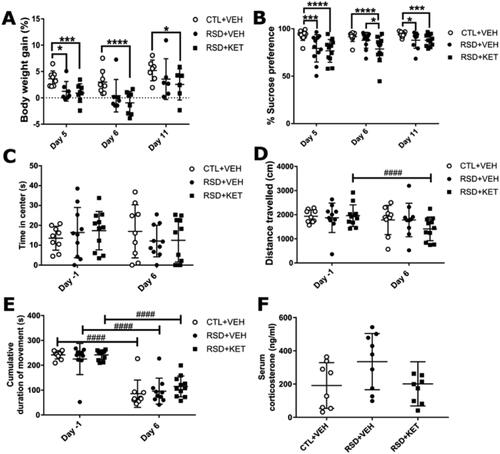Figures & data
Figure 1. Study design. Repeated social defeat (RSD) was performed on 5 consecutive days, from day 0 to 4. Sucrose preference test (SPT) training was performed from day -6 to day -3, followed by an overnight training session with one bottle of sucrose solution and another bottle with tap water (day -2 to -1). SPT test sessions were performed overnight at different time points: after RSD (day 4-5), after ketamine (KET) or vehicle (VEH) administration (day 5-6) and before termination (day-10-11). The open field test (OFT) was conducted before RSD (day -1) and after ketamine administration (day 6). Either ketamine (20 mg/kg) or 0.9% saline (VEH) was administered intraperitoneally one day after the last session of RSD (day 5). [11C]-PK11195 PET scans were performed on the last day of the experiment (day 11). On the same day, right before the PET scan, blood samples were collected for serum corticosterone measurements.
![Figure 1. Study design. Repeated social defeat (RSD) was performed on 5 consecutive days, from day 0 to 4. Sucrose preference test (SPT) training was performed from day -6 to day -3, followed by an overnight training session with one bottle of sucrose solution and another bottle with tap water (day -2 to -1). SPT test sessions were performed overnight at different time points: after RSD (day 4-5), after ketamine (KET) or vehicle (VEH) administration (day 5-6) and before termination (day-10-11). The open field test (OFT) was conducted before RSD (day -1) and after ketamine administration (day 6). Either ketamine (20 mg/kg) or 0.9% saline (VEH) was administered intraperitoneally one day after the last session of RSD (day 5). [11C]-PK11195 PET scans were performed on the last day of the experiment (day 11). On the same day, right before the PET scan, blood samples were collected for serum corticosterone measurements.](/cms/asset/3ff33e72-896c-4b96-8551-d4ec5175db92/ists_a_2045269_f0001_b.jpg)
Figure 2. Physiological and behavioral changes. (A) RSD induced a reduction in body weight gain which was not restored by ketamine injection. (B) Significant decrease in sucrose preference in the SPT is observed after RSD, which was not reversed by treatment with ketamine. (C) The open field test did not show any effect of RSD or ketamine on the time spent in the center of the arena, (D) on the distance traveled, or (E) on the total time they spent moving (cumulative duration of movement). (F) An increase in corticosterone serum concentrations due to RSD was observed, which was suppressed by ketamine treatment, but this difference was not statistically significant. Data are shown as mean ± SD. Statistically significant differences are indicated by asterisks: Between group comparison: *p < 0.05; **p < 0.01; ***p < 0.001; ****p < 0.0001; within group comparison ####p < 0.0001.

Table 1. [11C]-PK11195 uptake in the brain of control animals (CTL + VEH), and animals exposed to a 5-day repeated social defeat protocol followed by a single injection of 20 mg/kg ketamine (RSD + KET) or vehicle (RSD + VEH).
Data availability statement
Data is available upon request to the corresponding author.
